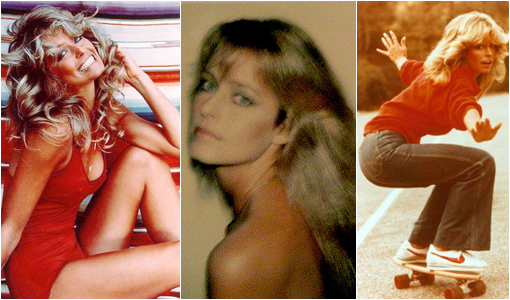Pop's Ragged Edges

When I was 14 years old I had two posters on the wall of my bedroom. The first a large image of a Porsche 928S and the second of Farrah Fawcett. She was every boys dream girl then. Farrah transcended the iconography of Marilyn Monroe’s forbidden sexuality by making female sexuality seem as natural as fresh cut grass. She was sexy but gentle. There was something very straight forward about her personality, a girl-next-door sensibility, relaxed and pure. Unlike the pop idols of today, the Britney Spears and Megan Fox’s, Farrah didn’t need to wear her sexuality on her sleeve. She didn’t need to leverage the underbelly of our lascivious desires. Farrah conquered the world with a one piece bathing suit of modest proportions. Like all celebrities she loved attention but unlike many, she was willing to risk it for her own principals.
I am lamenting the fact the King of Pop’s death is eclipsing that of an Angel’s. It is representative of the cultural choices we have made. We all loved Farrah (and the 1982 Thriller, Michael Jackson) because they were powerful in their innocence. Sure they wanted fame, but in our minds that was a fair exchange for their talent, their beauty and their irrepressible desire to please us.
Pop art emerged in the sixties as a response to post war cynicism. Warhol in particular, embraced mass media’s iconography and used it in order to reveal the very shallow depths of American culture. Warhol was in love with Pops ability to transcend the darkness of irony. He suggested Pop art and Pop culture were ways we could embrace our shallowness in a straight forward way. Warhol’s Pop for all its embrace of money, was intent on accepting shameless democracy. In 1977 there was something wonderfully democratic about Farrah Fawcett. She was literally the poster girl for American values, however shallow they might be. Today we are the pawns of huge corporate media conglomerates, but in 1977 we were not yet a demographic. The reason Farrah’s poster sold more than any other before or since, is because she crossed over demographics in true democratic style.
Charlie’s Angels began as a spoof, an exploitative half hour detective show that Hollywood’s soft-core king, Aaron Spelling thought an amusing titillation. However, Farrah, Kate and Jaclyn transcended Spelling’s sexism and made us pay attention to female intelligence in parallel to their physicality. Sure we watched in anticipation of the tight fitting outfits and the revealing swimsuits, but we also watched because it was enriching to watch intelligent, self-reliant women. Charlie’s Angels and The Bionic Woman were ground breaking in their empowerment of women. It made perfect sense that Julie Monroe (Farrah Fawcett) would marry the Six Million Dollar Man (Lee Majors). It was the astronaut and the model, but it was also the athletic, smart, sexy detective and the cybernetic man. Farrah once said; “God made man stronger but not necessarily more intelligent. He gave women intuition and femininity. And, used properly, that combination easily jumbles the brain of any man I’ve ever met.” Farrah was significant because she made conscious personal choices intent on breaking down stereotypes about women. She fought for her own just treatment by arguing for a fair portion of the proceeds from Charlie’s Angels profits. Profits that people like Spelling had profited from for years by marketing the images of young, vibrant women. She went on to take challenging roles in TV movies that dramatized the dark underbelly in the treatment of women through themes of spousal abuse (The Burning Bed) and rape (Extremities). She was the first to celebrate being an older woman by choosing to pose in Playboy at the age of 47. She was intent on converting her pop icon status into something richer, but she never lost her innocence reflected by her ever-endearing smile.
Farrah Fawcett found personal relationships within the world of Hollywood impossible and was often the brunt of tabloid journalism, but she understood exposure was a responsibility that should necessitate service. In her final months, knowing she was dying she chose to document her experience so that others might gain knowledge from it, even at the expense of her own image. A personal friend of Andy Warhol’s and an accomplished art collector and sculptor herself, Farrah believed, like Andy in the power of art, even Pop art or popular culture, to transcend the everyday. In the seventies popular television was a gateway to digging at the richer ideas underneath. M.A.S.H., Archie Bunker, The Jeffersons and yes even Charlie’s Angels served as mediums through which the average American could confront the more difficult issues of war, racism and sexism without having to admit to intellectual literacy. Let us not forget Farrah’s contributions and use this time to mourn her and in turn reflect on the type of world we’ve embraced over the one we once had.
